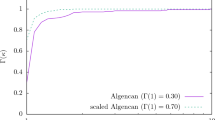Abstract
In this work, we propose a segment-based representation for the upper bound of the non-dominated set in interval branch & bound solvers for biobjective non linear optimization. We ensure that every point over the upper line segments is dominated by at least one point in the feasible objective region. Segments are generated by linear envelopes of the image of feasible line segments. Finally, we show that the segment-based representation together with methods for generating upper line segments allows us to converge more quickly to the desired precision of the whole strategy. The code of our solver can be found in our git repository (https://github.com/INFPUCV/ibex-lib/tree/master/plugins/optim-mop).






Similar content being viewed by others
Notes
Due to the infinite precision of real numbers, computer programs use IEEE-754 floating point numbers [19] for representing reals. Floating point numbers are composed by two integers: a mantissa m and an exponent e which together represent the real number \(m\cdot 2^e\).
For the CTP instances, we consider a function \(\phi =1+\sum _{i=2}^n x_i\), otherwise we obtain only one \(\epsilon \)-efficient solution: \(x=(0,0,\ldots )\), \(y=(0,1)\). For the CF3 instances, we consider a size \(n=5\) instead of \(n=2\), because with \(n=2\), we obtain the undetermined term 2/0 in the first objective.
References
Deb, K.: Multi-objective evolutionary algorithms. In: Kacprzyk J., Pedrycz W. (eds.) Springer Handbook of Computational Intelligence. Springer Handbooks. Springer, Berlin, Heidelberg (2015)
Miettinen, K.: Nonlinear Multiobjective Optimization, vol. 12. Springer, Berlin (2012)
Collette, Y., Siarry, P.: Multiobjective Optimization: Principles and Case Studies. Springer, Heidelberg (2013)
Evtushenko, Y.G., Posypkin, M.A.: Nonuniform covering method as applied to multicriteria optimization problems with guaranteed accuracy. Comput. Math. Math. Phys. 53(2), 144–157 (2013)
Žilinskas, A., Žilinskas, J.: Adaptation of a one-step worst-case optimal univariate algorithm of bi-objective Lipschitz optimization to multidimensional problems. Commun. Nonlinear Sci. Numer. Simul. 21(1–3), 89–98 (2015)
Pardalos, P.M., Žilinskas, A., Žilinskas, J.: Non-convex Multi-objective Optimization. Springer, New York (2017)
Ruetsch, G.: An interval algorithm for multi-objective optimization. Struct. Multidiscipl. Optim. 30(1), 27–37 (2005)
Fernández, J., Tóth, B.: Obtaining an outer approximation of the efficient set of nonlinear biobjective problems. J. Glob. Optim. 38(2), 315–331 (2007)
Fernández, J., Tóth, B.: Obtaining the efficient set of nonlinear biobjective optimization problems via interval branch-and-bound methods. Comput. Optim. Appl. 42(3), 393–419 (2009)
Kubica, B.J., Woźniak, A.: Tuning the interval algorithm for seeking Pareto sets of multi-criteria problems. In: Manninen, P., Öster, P. (eds.) International Workshop on Applied Parallel Computing, pp. 504–517. Springer, New York (2012)
Martin, B., Goldsztejn, A., Granvilliers, L., Jermann, C.: On continuation methods for non-linear bi-objective optimization: towards a certified interval-based approach. J. Glob. Optim. 64(1), 3–16 (2016)
Martin, B., Goldsztejn, A., Granvilliers, L., Jermann, C.: Constraint propagation using dominance in interval branch & bound for nonlinear biobjective optimization. Eur. J. Oper. Res. 260(3), 934–948 (2017)
Niebling, J., Eichfelder, G.: A branch-and-bound based algorithm for nonconvex multiobjective optimization. SIAM J. Optim. 29(1), 794–821 (2019)
Araya, I., Campusano, J., Aliquintui, D.: Nonlinear biobjective optimization: improvements to interval branch & bound algorithms. J. Glob. Optim. 75(1), 91–110 (2019)
Goldsztejn, A., Domes, F., Chevalier, B.: First order rejection tests for multiple-objective optimization. J. Glob. Optim. 58(4), 653–672 (2014)
Hansen, E., Walster, G.W.: Global Optimization using Interval Analysis: Revised and Expanded, vol. 264. CRC Press, Boca Raton (2003)
Jaulin, L., Kieffer, M., Didrit, O., Walter, E.: Applied Interval Analysis. Springer, Berlin (2001)
Kutateladze, S.: Convex e-programming. Sov. Math. Dokl 20(2), 391–393 (1979)
Kahan, W.: IEEE standard 754 for binary floating-point arithmetic. Lect. Notes Status IEEE 754(94720–1776), 11 (1996)
Araya, I., Trombettoni, G., Neveu, B., Chabert, G.: Upper bounding in inner regions for global optimization under inequality constraints. J. Glob. Optim. 60(2), 145–164 (2014)
Araya, I., Trombettoni, G., Neveu, B.: A contractor based on convex interval taylor. In: Beldiceanu, N., Jussien N., Pinson, É. (eds.) Integration of AI and OR Techniques in Contraint Programming for Combinatorial Optimzation Problems, pp. 1–16. Springer, New York (2012)
Hladík, M., Horáček, J.: Interval linear programming techniques in constraint programming and global optimization. In: Ceberio, M., Kreinovich, V. (eds.) Constraint Programming and Decision Making, pp. 47–59. Springer, New York (2014)
Lebbah, Y., Michel, C., Rueher, M., Daney, D., Merlet, J.: Efficient and safe global constraints for handling numerical constraint systems. SIAM J. Numer. Anal. 42(5), 2076–2097 (2005)
Ninin, J., Messine, F., Hansen, P.: A reliable affine relaxation method for global optimization. 4OR 13(3), 247–277 (2015)
Jaulin, L.: Reliable minimax parameter estimation. Reliab. Comput. 7(3), 231–246 (2001)
Spielman, D.A., Teng, S.-H.: Smoothed analysis of algorithms: why the simplex algorithm usually takes polynomial time. J. ACM (JACM) 51(3), 385–463 (2004)
Chabert, G., Jaulin, L.: Contractor programming. Artif. Intell. 173, 1079–1100 (2009)
Benhamou, F., Goualard, F., Granvilliers, L., Puget, J.-F.: Revising hull and box consistency. In: Int. Conf. on Logic Programming. Citeseer, Las Cruces (1999)
Trombettoni, G., Chabert, G.: Constructive interval disjunction. In: Bessière, C. (ed.) Principles and Practice of Constraint Programming (CP 2007), pp. 635–650. Springer, New York (2007)
Csendes, T., Ratz, D.: Subdivision direction selection in interval methods for global optimization. SIAM J. Numer. Anal. 34(3), 922–938 (1997)
Moore, R.: Interval Analysis. Prentice-Hall, Englewood Cliffs (1966)
Araya, I., Neveu, B.: lSMEAR: a variable selection strategy for interval branch and bound solvers. J. Glob. Optim. 71(3), 483–500 (2018)
Wilcoxon, F., Katti, S., Wilcox, R.A.: Critical values and probability levels for the Wilcoxon rank sum test and the Wilcoxon signed rank test. Sel. Tables Math. Stat. 1, 171–259 (1970)
Dolan, E.D., Moré, J.J.: Benchmarking optimization software with performance profiles. Math. Progr. 91(2), 201–213 (2002)
Acknowledgements
This work is supported by the Fondecyt Project 1200035.
Author information
Authors and Affiliations
Corresponding author
Additional information
Publisher's Note
Springer Nature remains neutral with regard to jurisdictional claims in published maps and institutional affiliations.
Rights and permissions
About this article
Cite this article
Araya, I., Aliquintui, D., Ardiles, F. et al. Nonlinear biobjective optimization: improving the upper envelope using feasible line segments. J Glob Optim 79, 503–520 (2021). https://doi.org/10.1007/s10898-021-00991-7
Received:
Accepted:
Published:
Issue Date:
DOI: https://doi.org/10.1007/s10898-021-00991-7




